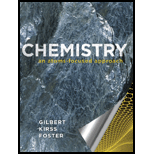
Chemistry: An Atoms-Focused Approach
14th Edition
ISBN: 9780393912340
Author: Thomas R. Gilbert, Rein V. Kirss, Natalie Foster
Publisher: W. W. Norton & Company
expand_more
expand_more
format_list_bulleted
Question
Chapter 12, Problem 12.15QA
Interpretation Introduction
To rank:
Containers in order of increasing number of microstates accessible to the particles inside them.
Expert Solution & Answer
Want to see the full answer?
Check out a sample textbook solution
Students have asked these similar questions
Draw the most likely mechanism for the following
d.
'Ph
Draw the most likely mechanism for the following
Chapter 12 Solutions
Chemistry: An Atoms-Focused Approach
Ch. 12 - Prob. 12.1VPCh. 12 - Prob. 12.2VPCh. 12 - Prob. 12.4VPCh. 12 - Prob. 12.5VPCh. 12 - Prob. 12.6VPCh. 12 - Prob. 12.8VPCh. 12 - Prob. 12.9VPCh. 12 - Prob. 12.10VPCh. 12 - Prob. 12.11QACh. 12 - Prob. 12.12QA
Ch. 12 - Prob. 12.13QACh. 12 - Prob. 12.14QACh. 12 - Prob. 12.15QACh. 12 - Prob. 12.16QACh. 12 - Prob. 12.17QACh. 12 - Prob. 12.18QACh. 12 - Prob. 12.19QACh. 12 - Prob. 12.20QACh. 12 - Prob. 12.21QACh. 12 - Prob. 12.22QACh. 12 - Prob. 12.23QACh. 12 - Prob. 12.24QACh. 12 - Prob. 12.25QACh. 12 - Prob. 12.26QACh. 12 - Prob. 12.27QACh. 12 - Prob. 12.28QACh. 12 - Prob. 12.29QACh. 12 - Prob. 12.30QACh. 12 - Prob. 12.31QACh. 12 - Prob. 12.32QACh. 12 - Prob. 12.33QACh. 12 - Prob. 12.34QACh. 12 - Prob. 12.35QACh. 12 - Prob. 12.36QACh. 12 - Prob. 12.37QACh. 12 - Prob. 12.38QACh. 12 - Prob. 12.39QACh. 12 - Prob. 12.40QACh. 12 - Prob. 12.41QACh. 12 - Prob. 12.42QACh. 12 - Prob. 12.43QACh. 12 - Prob. 12.44QACh. 12 - Prob. 12.45QACh. 12 - Prob. 12.46QACh. 12 - Prob. 12.47QACh. 12 - Prob. 12.48QACh. 12 - Prob. 12.49QACh. 12 - Prob. 12.50QACh. 12 - Prob. 12.51QACh. 12 - Prob. 12.52QACh. 12 - Prob. 12.53QACh. 12 - Prob. 12.54QACh. 12 - Prob. 12.55QACh. 12 - Prob. 12.56QACh. 12 - Prob. 12.57QACh. 12 - Prob. 12.58QACh. 12 - Prob. 12.59QACh. 12 - Prob. 12.60QACh. 12 - Prob. 12.61QACh. 12 - Prob. 12.62QACh. 12 - Prob. 12.63QACh. 12 - Prob. 12.64QACh. 12 - Prob. 12.65QACh. 12 - Prob. 12.66QACh. 12 - Prob. 12.67QACh. 12 - Prob. 12.68QACh. 12 - Prob. 12.69QACh. 12 - Prob. 12.70QACh. 12 - Prob. 12.71QACh. 12 - Prob. 12.72QACh. 12 - Prob. 12.73QACh. 12 - Prob. 12.74QACh. 12 - Prob. 12.75QACh. 12 - Prob. 12.76QACh. 12 - Prob. 12.77QACh. 12 - Prob. 12.78QACh. 12 - Prob. 12.79QACh. 12 - Prob. 12.80QACh. 12 - Prob. 12.81QACh. 12 - Prob. 12.82QACh. 12 - Prob. 12.83QACh. 12 - Prob. 12.84QACh. 12 - Prob. 12.85QACh. 12 - Prob. 12.86QA
Knowledge Booster
Similar questions
- a. OH H₂N-O -Ph H+ acyclic productarrow_forwardeks.com/aleksogi/x/sl.exe/1o_u-IgNslkr7j8P3jH-IQs_pBanHhvTCeeBZbufuBYTI0Hz7m7D3ZS17Hd6m-HIl6n52njJN-TXdQA2X9yID-1SWQJTgnjARg30 111 States of Matter Understanding conceptual components of the enthalpy of solution 0/5 Ge A small amount of acetonitrile (CH, CN) is dissolved in a large amount of water. Imagine separating this process into the four stages sketched below. (These sketches show only a portion of the substances, so you can see the density and distribution of atoms and molecules in them.) CH,CN H₂O B 88 C Use these sketches to answer the questions in the table below. The enthalpy of solution AH is negative soln when CH3CN dissolves in water. Use this information to list the stages in order of increasing enthalpy. Would heat be absorbed or released if the system moved from Stage C to D? What force would oppose or favor the system moving from Stage C to D? Check all that apply. 1 absorbed O released neither absorbed nor released. none O ionic bonding force covalent bonding force…arrow_forwardIn a system with an anodic overpotential, the variation of ŋ as a function of the current density: 1. at low fields is linear 2. at higher fields, it follows Tafel's law Find the range of current densities for which the overpotential has the same value as when calculated for cases 1 and 2 (maximum relative difference of 5% with respect to the behavior for higher fields). To which overpotential range does this correspond? Data: 10 = 1.5 mA cm², T = 300°C, ẞ = 0.64, R = 8.314 J K 1 mol¹ and F = 96485 C mol-1.arrow_forward
arrow_back_ios
SEE MORE QUESTIONS
arrow_forward_ios
Recommended textbooks for you
 ChemistryChemistryISBN:9781305957404Author:Steven S. Zumdahl, Susan A. Zumdahl, Donald J. DeCostePublisher:Cengage Learning
ChemistryChemistryISBN:9781305957404Author:Steven S. Zumdahl, Susan A. Zumdahl, Donald J. DeCostePublisher:Cengage Learning ChemistryChemistryISBN:9781259911156Author:Raymond Chang Dr., Jason Overby ProfessorPublisher:McGraw-Hill Education
ChemistryChemistryISBN:9781259911156Author:Raymond Chang Dr., Jason Overby ProfessorPublisher:McGraw-Hill Education Principles of Instrumental AnalysisChemistryISBN:9781305577213Author:Douglas A. Skoog, F. James Holler, Stanley R. CrouchPublisher:Cengage Learning
Principles of Instrumental AnalysisChemistryISBN:9781305577213Author:Douglas A. Skoog, F. James Holler, Stanley R. CrouchPublisher:Cengage Learning Organic ChemistryChemistryISBN:9780078021558Author:Janice Gorzynski Smith Dr.Publisher:McGraw-Hill Education
Organic ChemistryChemistryISBN:9780078021558Author:Janice Gorzynski Smith Dr.Publisher:McGraw-Hill Education Chemistry: Principles and ReactionsChemistryISBN:9781305079373Author:William L. Masterton, Cecile N. HurleyPublisher:Cengage Learning
Chemistry: Principles and ReactionsChemistryISBN:9781305079373Author:William L. Masterton, Cecile N. HurleyPublisher:Cengage Learning Elementary Principles of Chemical Processes, Bind...ChemistryISBN:9781118431221Author:Richard M. Felder, Ronald W. Rousseau, Lisa G. BullardPublisher:WILEY
Elementary Principles of Chemical Processes, Bind...ChemistryISBN:9781118431221Author:Richard M. Felder, Ronald W. Rousseau, Lisa G. BullardPublisher:WILEY

Chemistry
Chemistry
ISBN:9781305957404
Author:Steven S. Zumdahl, Susan A. Zumdahl, Donald J. DeCoste
Publisher:Cengage Learning

Chemistry
Chemistry
ISBN:9781259911156
Author:Raymond Chang Dr., Jason Overby Professor
Publisher:McGraw-Hill Education

Principles of Instrumental Analysis
Chemistry
ISBN:9781305577213
Author:Douglas A. Skoog, F. James Holler, Stanley R. Crouch
Publisher:Cengage Learning

Organic Chemistry
Chemistry
ISBN:9780078021558
Author:Janice Gorzynski Smith Dr.
Publisher:McGraw-Hill Education

Chemistry: Principles and Reactions
Chemistry
ISBN:9781305079373
Author:William L. Masterton, Cecile N. Hurley
Publisher:Cengage Learning

Elementary Principles of Chemical Processes, Bind...
Chemistry
ISBN:9781118431221
Author:Richard M. Felder, Ronald W. Rousseau, Lisa G. Bullard
Publisher:WILEY